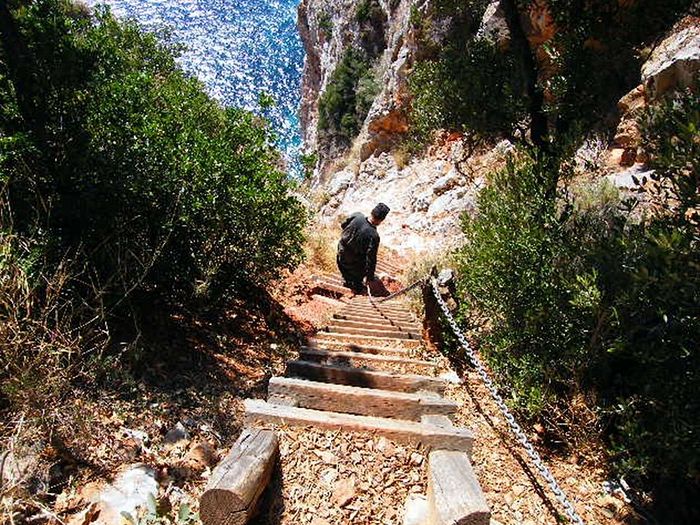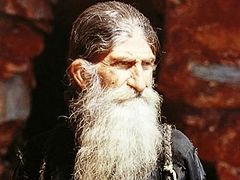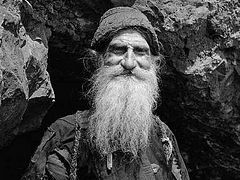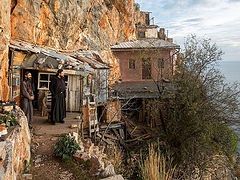Elder Parthenios came from a noble line of Russian tsars and at age eighteen became a monk in the kellia of St. Nicholas “Bourazeri”. He labored in obedience, humility, and contrition of thought as the coenobitic life teaches, but nevertheless his thirst for perfect hesychia made him leave his kellia for Karoulia, where he showed self denial and love for all the hesychastic fathers there, whom he viewed as holy angels of God in the flesh. In general, he helped everyone, but he never allowed anyone into his own cell, in order to hide the fact that he slept on the floor of the cave and never on a bed.
His outward appearance was Biblical, and it was enough to look at his face to guess his noble origins. His hands never parted with his prayer rope, nor his lips with prayer. When people saw him they experienced fear mixed with admiration. He inspired respect from everyone, and everyone loved him. Nevertheless, due to his many podvigs he did not live very long. God called him to the heavenly chambers so that he might ever rejoice there with the eternal God, Father, Son, and Holy Spirit.
Elder Zosima, the basket weaver
Another monk worthy of remembrance and filled to overflowing with virtues was Elder Zosima, a former officer of high rank in the Russian army, who after the fall of the tsarist regime visited the Monastery of St. Panteliemon and then the Skete of St. Andrew, called also “Serai”, and the Skete of the Prophet Elias (sketes that were built and inhabited by Russian monks), but he did not remain in any of them; his soul found rest on the steep cliffs and slopes of Karoulia.
So that he would not be a burden on anyone, he learned to weave baskets. This was his handiwork, which brought him his daily bread. Prayer was always on his lips, as for all monks, and the remembrance of death was always before his eyes—especially after everything he had seen and experienced during the years of revolution and war in his native land. He was beloved by all, and the All-Good God took him in deep old age to the Kingdom of Heaven.
Stamatos the Robber
This robber committed innumerable robberies in the area around the Chalkidiki peninsula, until, as legend tells, he came to even rob monks on Holy Mount Athos itself.
One day, he decided along with two youths to rob one of the kellias located a long distance from Karyes and standing on its own apart from the other kellias. This very old kellia belongs to the Monastery of the Pantocrator, and it has a church dedicated to St. George Phaneromenos. As Fr. Joachim, my elder, told me—and this was confirmed by the fathers of the Daniel brotherhood who also heard about it from their elders, and they, from their great grandfather, Elder Daniel the First—that robber set out to rob this kellia, which was considered one of the wealthiest kellias in Karyes.
As is known, during the years of Turkish enslavement all the mountains of our country were teeming with thieves and of robber bands. These robbers were watching in ambush and found out that in this kellia lived two helpless old men, with lots of money. The robbers did not think long about it. At midnight they set out for the kellia and knocked at the gates. They heard a voice asking who it was and what they wanted at such an hour. The robbers did not answer and continued to bang on the gates. At one moment their leader, Stamatos, shouted in an imperious tone:
“Open the gates! We are pilgrims, seeking a place to stay for the night!”
A young man opened the gates and asked what brought them to the kellia. Not hiding their weapons, they told him that they needed to talk to the abbot. Just the same, they were surprised to see a youth in the kellia, since they knew that only two old men lived there. He led them to the guesthouse, the “archondariki”, and said, “Wait here while I call the abbot.
St. George works a miracle
The robbers sat down and waited for the abbot. An hour passed, then two, but neither the abbot nor anyone else appeared; total quietude and silence reigned throughout the house. Then the robbers lost their patience and wanted to get up and start plundering as they had decided to do from the start, to take everything of value from the money to the silver oil lamps—whatever they could find. So they tried to stand up, but they couldn’t move to the right or to the left, and they couldn’t move their arms or legs. They were unable to move from the spot, as if they were chained to it in manacles.
Then the armed robbers started shouted and asking for help from the weak and infirm old men. Hearing the shouts, the old monks jumped up frightened from their sleep and ran to the place where the noise was coming from, and what did they see? The robbers, who although they were not bound by anything could not make the slightest movement. The elders asked them:
“Who are you? What do you seek here? Why did you come, and how did you get into our home? Who opened the gates to you and let you in?”
The robbers at first cursed and threatened:
“We’ll cut your throats like goats! You’ve bewitched us and petrified us here! Let us go if you want to stay alive! Why did you bind us? We are good people, we have not come to do you any harm.”
Finally understanding that they had less strength than those old men and could do nothing, the robbers broke into tears and started begging that the monks unbind them. The monks asked them in gentle and calm voices:
“Brothers, how did you get into our home? Who let you in, and what do you want from us?”
The robbers in tears told them about the evils that had come upon their heads:
Understanding that a miracle had happened, the elders ran to the church, took the icon of holy Great Martyr George, and showed it to the robbers. When the latter saw the icon they were frightened, and in one voice shouted:
“Yes, that’s the man who let us in!”
And right then and there, after they repented, they jumped up from their place, fell down and bowed before the icon of St. George, exclaiming joyfully:
“He appeared to us, and now he’s freed us from those invisible bonds!”
They brought forth repentance for their evil deeds and gave many gifts to that kellia, including an icon of St. George, which has ever since been called “St. George Phaneromenos”, meaning, “The appeared”.
After this great miracle the robber, as the Daniel brotherhood assured us, repented, quit all of his robbing and left for Karoulia. There he built a tiny kaliva with a little church dedicated to St. George, and became a monk with the name Stamatos.
They say that he was the first to settle in Karoulia. In this desert he found peace and rest for his soul, spending the rest of his life in sincere repentance and contrition of heart, confessing his sins every day. He made such progress in the spiritual life that a monk of the Lavra, later Metropolitan of Karitsa and professor of Athens University Eulogios (Kourilas), as Elder Daniel of Kantounakia writes, found in the documents of the monastery of the Great Lavra that “Elder Stamatos, the former robber, was a holy monk and was vouchsafed a venerable end.”
From the book, Monk Andrew the Hagiorite. Patericon of the Holy Mountain (Monahul Andrei Aghioritul. Patericul Sfântului Munte. Editura Sophia, 2013. Р. 205–218).




